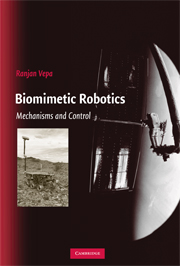Book contents
- Frontmatter
- Contents
- Preface
- Acronyms
- 1 The Robot
- 2 Biomimetic Mechanisms
- 3 Homogeneous Transformations and Screw Motions
- 4 Direct Kinematics of Serial Robot Manipulators
- 5 Manipulators with Multiple Postures and Compositions
- 6 Grasping: Mechanics and Constraints
- 7 Jacobians
- 8 Newtonian, Eulerian, and Lagrangian Dynamics
- 9 Path Planning, Obstacle Avoidance, and Navigation
- 10 Hamiltonian Systems and Feedback Linearization
- 11 Robot Control
- 12 Biomimetic Motive Propulsion
- Answers to Selected Exercises
- Appendix: Attitude and Quaternions
- Bibliography
- Index
6 - Grasping: Mechanics and Constraints
Published online by Cambridge University Press: 20 February 2010
- Frontmatter
- Contents
- Preface
- Acronyms
- 1 The Robot
- 2 Biomimetic Mechanisms
- 3 Homogeneous Transformations and Screw Motions
- 4 Direct Kinematics of Serial Robot Manipulators
- 5 Manipulators with Multiple Postures and Compositions
- 6 Grasping: Mechanics and Constraints
- 7 Jacobians
- 8 Newtonian, Eulerian, and Lagrangian Dynamics
- 9 Path Planning, Obstacle Avoidance, and Navigation
- 10 Hamiltonian Systems and Feedback Linearization
- 11 Robot Control
- 12 Biomimetic Motive Propulsion
- Answers to Selected Exercises
- Appendix: Attitude and Quaternions
- Bibliography
- Index
Summary
Forces and Moments
In the analyses of robot mechanisms considered in the preceding chapters, the influence of forces on the components was not considered. However, any analyses of the mechanics of such tasks as grasping a body must include an analysis of the forces acting on the components, the reactions to these applied forces, and the other consequences of the application of the force system.
Forces may be construed to have primary effects. In the first instance, forces acting on stationary rigid bodies generate internal reactions, and together they ensure that the body is in static equilibrium or in a state of rest. A state of static equilibrium is a state in which the rigid body experiences no acceleration. For a rigid body idealized as a single free particle so its orientation is unimportant, static equilibrium implies that there is no acceleration in any direction. For a general rigid body, static equilibrium not only implies that there is no acceleration in any direction but also that there is no angular acceleration in any direction.
The second and probably the more important of the two effects of forces acting on a rigid body is the production of acceleration. The moment of a force about any line is the product of the magnitude of a component of the force normal to the line and the perpendicular distance of this component from the line. The moment of two equal but opposite forces not acting at the same point about any line is a couple. A torque acting on a body with no net force is the resultant of one or more couples acting about the same line.
- Type
- Chapter
- Information
- Biomimetic RoboticsMechanisms and Control, pp. 111 - 119Publisher: Cambridge University PressPrint publication year: 2009

